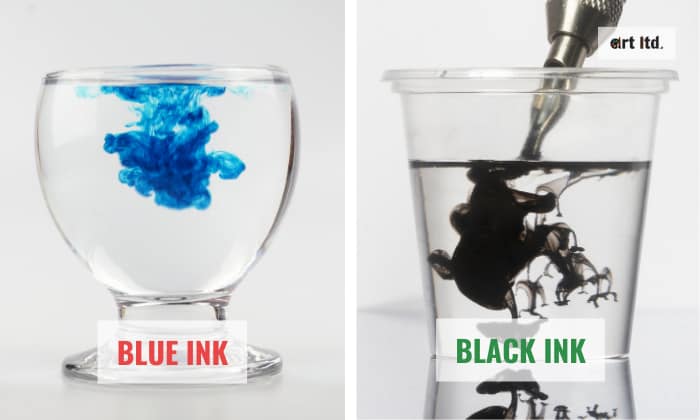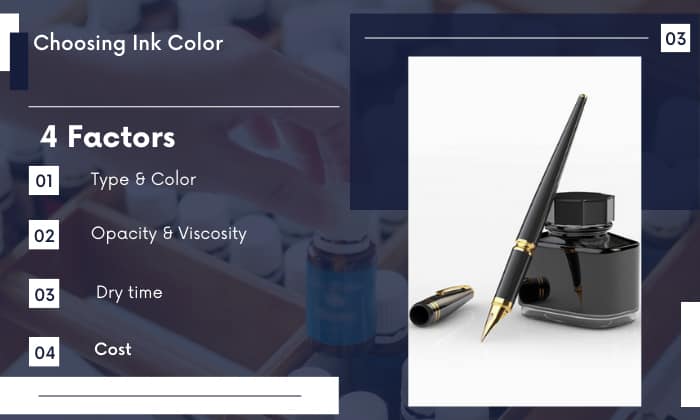As small as it may seem, choosing between blue or black ink can be time-consuming for some people.
Whether signing important documents, jotting down notes, or expressing ourselves through creative writing, the color of ink we use can influence our thought processes.
Some believe that black ink is the only professional choice, while others say that blue ink adds a touch of creativity and personality.
Explore the differences between them and decide which one is the most suitable for you.
Table of Contents
What Are They?
Black ink and blue ink are two common colors of ink used for writing and printing. They are made from different pigments and dyes, giving them their distinct colors.
Both black and blue ink can be found in various writing instruments, including pens, markers, and fountain pens.
Differences
- Material: Black ink is typically made from carbon powder and water or oil if it’s pigment-based and colorants dissolved in a liquid if it’s dye-based.
Blue ink, on the other hand, is usually made from synthetic dyes like Triarylmethane, which creates a bright, vivid blue color.
- Perception: Blue ink is often associated with creativity, expression, and individuality, whereas black ink is associated with formality, authority, and professionalism.
- Cost: Black ink is not as expensive as blue ink because carbon black is cheaper than other pigments.
Pros and Cons
1. Blue ink
- Make your writing stand out and show your individuality (a warm and friendly person).
- Associated with creativity and imagination.
- Fades over time.
- Can be perceived as unprofessional or casual in some settings.
2. Black ink
- More resistant to fading and smudging than other colors of ink, making it a good choice for archival documents and important records.
- Too ordinary or dull compared to other colors of ink, which can be a downside if you are looking for an expressive writing experience.
When to Use Them?
1. Blue ink
- Credit card application
Banks and credit card companies prefer blue ink because it helps them easily confirm the authenticity and originality of documents, making them suitable for checks and papers you need to sign.
Compared to black ink, blue ink signatures are more difficult to reproduce or counterfeit, preventing fraudsters from creating fake documents or forged signatures.
- Legal documents
For legal documents, such as real estate purchases, loans, mortgage agreements, etc., the content printed with black and blue ink can make a clear contrast.
- Notarizing documents
Most notaries now prefer to use blue ink because it is easier to distinguish between an original document and a copy when using blue ink.
- Study documents
Blue is a soothing color that is better for memory. When you take notes in blue ink, your notes will stand out from the printed black text on the page, making them easier to read and remember.
This is very helpful for studying, when students have to prepare for exams or try to memorize important information.
2. Black ink
- Business or work documents
Black ink provides a clear and legible image because it has higher contrast than blue ink when printed or copied.
It is also considered to be more professional and formal than blue ink. This is particularly true in business and work, where using blue ink may be seen as more casual.
Using black ink helps convey a sense of seriousness and importance and may be more appropriate for official documents.
- Passport forms
Black ink is often used for passport application because it is easier to scan and reproduce accurately than blue ink.
Using black ink reduces the chances of errors or issues with the scanned or copied document, which can help speed up the passport application process.
- Tax returns
The Internal Revenue Service (IRS) requires that all tax forms be written in black ink to ensure that the forms will be read and processed accurately.
Thus, if you are filing your tax returns by mail and filling out the forms by hand, use black ink to avoid any issues with the acceptance of the forms.
- Tattoo
Black is the most popular color in the tattoo world. The reason is that black is usually cheaper than other colors and accentuates skin tones.
Which is Better?
It depends on the context in which you are using a blue or black pen:
- Who can use black pen for signature? Black ink is generally the preferred choice if you are writing a formal document or in a professional setting.
- On the other hand, blue ink can be seen as more playful, so writing in blue ink is a better choice in creating artistic writing.
- In terms of legibility, black and blue ink are both considered legible, especially for learning materials.
Ink Color Psychology – What is the Significance of Ink Colors?
Pen ink color meanings may vary in many different ways. Below are the meanings of blue and black ink:
1. Blue ink
- Calming: Blue is often associated with calming the mind and body. It can create a sense of relaxation and tranquility.
- Trustworthy: Dependability is also a blue ink meaning. It can create a sense of reliability and loyalty, especially in business.
- Creativity: Blue ink is often seen as more creative and imaginative than other ink types. It may be used to show enthusiasm and encourage productivity.
2. Black ink
- Formality: Black can create a sense of sophistication, seriousness, elegance, and professionalism.
- Authority: Black is also often associated with power and control. It can create a sense of strength and dominance.
- Intensity: Black can create a sense of intensity, depth, and mystery.
Factors to Consider When Choosing Ink Color
- Type & Color
You can choose the color of the ink you like, then select between different types of ink, including dye-based, pigment-based, solvent-based, and water-based.
Pigment-based ink tends to be more water-resistant than dye-based ink, for instance.
In terms of colors, it is best to avoid red, green, or any color that is not black or blue when sitting for exams, singing checks, or writing any important documents. You can opt for brighter pigments in personal correspondence like letters and postcards to friends.
- Opacity & Viscosity: Inks that are pigment-based tend to be more opaque and thicker than dye-based inks, which can affect the final appearance of the print.
- Dry time: Some inks dry quickly, while others may take longer to dry and require additional handling time. For example, solvent-based inks dry faster than water-based inks.
- Cost: Some inks may be more expensive than others. For example, black ink is always cheaper than other colored ink.
Frequently Asked Questions
Does the ink color affect the lifespan of the pen?
No. Ink color generally does not affect the lifespan of the pen itself. The lifespan of a pen depends on several factors, such as:
- Pens made with high-quality materials such as durable metals and strong plastics are likely to last longer.
- Frequency of use: The more often a pen is used, the faster it may wear down.
- Writing pressure: The pressure with which a pen is used can also affect its lifespan. Pens that are used with a heavy hand or pressed down too hard may wear down faster than those used with a lighter touch.
Can I mix blue and black ink together?
You can mix blue and black ink to create a new color. The resulting color will depend on the blue-to-black ink ratio you use.
- If you mix equal amounts of blue and black ink, the resulting color will likely be dark blue or navy blue.
- If you use more blue ink than black ink, the resulting color will be lighter and more blue-toned.
- On the other hand, if you use more black ink than blue ink, the resulting color will be darker and more black-toned.
Conclusion
In conclusion, the choice between blue or black ink comes down to personal preference and the context in which the writing will be used.
Blue ink is often preferred for casual contexts like studying, while black ink is seen as more formal and professional and used in medical documents or legal contexts.
However, both colors have their advantages and can be used effectively in a variety of situations.
You can try different pigments and types of ink to find your favorite color, which can be a fun and creative way to enhance the writing experience.

Art has always been a part of my life; it influences my upbringing and later my career choice. For me, it is always a part of my parenting technique. So for whichever purpose that you come to art, you can start here with us.














